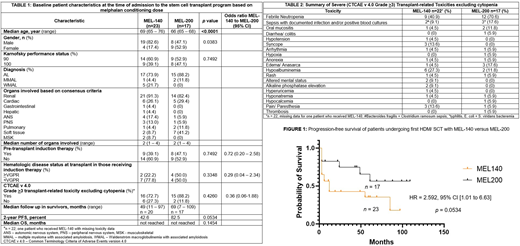Introduction: High dose melphalan and autologous stem cell transplantation (HDM/SCT) results in deep and durable responses and prolonged survival in highly selected patients with systemic immunoglobulin light chain (AL) amyloidosis. HDM/SCT is offered to select patients >65 years but melphalan dose is often reduced due to concerns for tolerability and toxicities in older patients. However, older adults are a diverse population and chronological age alone does not accurately predict chemotherapy tolerance. While both melphalan 140 mg/m2 (MEL-140) and 200 mg/m2 (MEL-200) are commonly used in clinical practice, there are very few studies comparing these two doses in older patients. Available studies suggest that MEL-140 may be associated with worse event-free survival and progression-free survival, but it is unclear whether this is confounding for increased co-morbidities and frailty in this group. We report transplant-related toxicities and outcomes in patients >65 years undergoing first HDM/SCT with MEL-140 versus MEL-200 within 12 months of diagnosis of AL amyloidosis.
Methods: We analyzed transplant-related toxicities and outcomes of patients >65 years who received first HDM/SCT within 12 months of diagnosis between January 2011 and June 2020. We excluded patients receiving additional conditioning agents and those undergoing tandem or second transplantation. Patients were stratified based on melphalan dose. All statistical analyses were performed using GraphPad Prism version 8©. Independent (unpaired) t tests with unequal variance and a 95% confidence interval were used to calculate the two-tailed p values for continuous variables. Chi-squared tests were used to compare categorical variables. Hazard ratios (HR) and odds ratios (OR) with 95% confidence intervals (CI) and p values are reported. The Kaplan-Meier method was used to estimate progression-free survival (PFS) and overall survival (OS) and log-rank tests were used to compare the survival measurements of each group. In this cohort, PFS was defined as the time from SCT to hematologic progression, next line of therapy and/ or death, whichever came first. Transplant-related mortality was defined as death occurring within 100 days of SCT.
Results: Forty patients were included in the final analysis with a median follow up of 55.0 months (range 7 - 109, n = 18) for surviving patients in both groups. Table 1 displays patient and disease characteristics, transplant-related toxicities, 2-year PFS and median OS. Patients receiving MEL-140 were older (69 versus 66 years, p <0.0001) and more likely to be male (82.6% versus 47.1%, p 0.0383). Karnofsky performance status (KPS) was similar in both groups. Median number of organs involved was 2 with 91.3% and 82.4% of patients having renal involvement in the MEL-140 and MEL-200 groups, respectively. For patients who underwent induction therapy with anti-plasma cell agents, 22.2% treated with MEL-140 and 50.0% treated with MEL-200 were in >VGPR prior to HDM/ SCT (p 0.3348). There was no transplant-related mortality observed in either group. Severe transplant-related toxicities (grade >3) were reported in 88.2% of the MEL-200 group versus 72.7% of the MEL-140 group (p 0.4260) but the frequency of various toxicities were different. Patients who underwent conditioning with MEL-200 were significantly more likely to experience febrile neutropenia, sepsis and infections (88.2%, n = 15 versus 50.0%, n = 11; OR 0.13, 95% CI 0.03 - 0.73, p 0.0173 [Table 2]). Notably, the 2-year PFS was almost twice as long in the MEL-200 group (82.5% versus 42.6%, p 0.0534 [Figure 1]). The median PFS was 12.1 months in the MEL-140 group but was not reached in the MEL-200 group. There was no difference in median OS among the two groups (not reached, p 0.1454).
Conclusion: Our study results suggest that highly selected patients ≥65 years with good performance status can safely undergo melphalan at a dose of 200 mg/m2 prior to stem cell transplantation in AL amyloidosis although there may be an increased risk of febrile neutropenia, sepsis and infections. Additionally, the melphalan conditioning dose 140 mg/m2 is potentially associated with a significantly shorter progression-free survival than 200 mg/m2 in older patients undergoing HDM/SCT for AL amyloidosis.
Sanchorawala:Takeda: Research Funding; Caelum: Research Funding; Oncopeptide: Research Funding; Regeneron: Other: advisory board; Caleum: Other: advisory board; Proclara: Other: advisory board; Abbvie: Other: advisory board; UpToDate: Patents & Royalties; Prothena: Research Funding; Janssen: Research Funding; Celgene: Research Funding.
Author notes
Asterisk with author names denotes non-ASH members.


